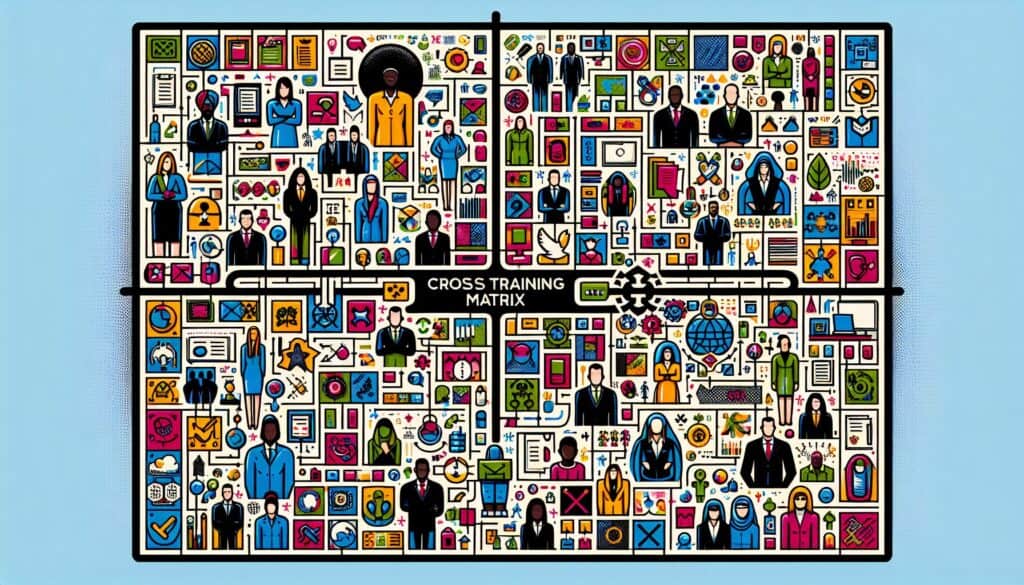Zur visuellen Darstellung der Fähigkeiten von Teammitgliedern für verschiedene Aufgaben oder Kompetenzen.
- Methodologien: Maschinenbau, Qualität
Cross-Training-Matrix

Cross-Training-Matrix
- Integration des Capability Maturity Model (CMMI), Änderungsmanagement, Kontinuierliche Verbesserung, Schlanke Fertigung, Projektmanagement, Qualitätsmanagement, Ausbildung
Zielsetzung:
Wie es verwendet wird:
- Ein Raster, das Teammitglieder und die für einen Prozess oder eine Abteilung erforderlichen Fähigkeiten oder Aufgaben auflistet. Es verwendet Symbole oder Bewertungen, um die Kompetenzstufen der einzelnen Mitglieder für jede Fähigkeit anzugeben.
Vorteile
- Identifies skill gaps and training needs; Facilitates better workforce planning and flexibility; Supports employee development; Improves team Vielseitigkeit and reduces dependency on single individuals.
Nachteile
- Kann zeitaufwändig in der Erstellung und Pflege sein, vor allem bei großen Teams oder dynamischen Qualifikationsgruppen; Subjektivität bei der Bewertung von Qualifikationsniveaus, wenn sie nicht auf klaren Kriterien beruht; Kann bei den Mitarbeitern Ängste auslösen, wenn sie nicht kommuniziert und konstruktiv eingesetzt werden.
Kategorien:
- Personalwesen, Herstellung, Projektmanagement
Am besten geeignet für:
- Verwaltung und Entwicklung von Teamfähigkeiten, Gewährleistung operativer Flexibilität und Ermittlung des Schulungsbedarfs.
The Cross Training Matrix is often utilized across diverse industries such as manufacturing, software development, healthcare, and project management, facilitating efficient allocation of roles during various phases of product development and operational processes. This methodology is beneficial in environments where collaboration is vital, allowing teams to assess not just current skills but also potential skill sets that can enhance team performance. For example, a software development team may employ the matrix to identify which developers can assist in quality assurance or customer service, ensuring that the team maintains momentum even in the absence of specific members. Typical participants in this process include team leads, project managers, and Humanressourcen personnel, who collectively identify key skills necessary for project success and evaluate team members against these requirements. The identification of proficiency levels prompts targeted training initiatives, enhancing skill diversity and ensuring that employees are well-equipped to handle various tasks, thereby reducing reliance on any single team member. In practice, this methodology can be particularly advantageous when launching new products or scaling operations, as it allows for a more adaptable workforce capable of responding to changing demands in the market. Through the assessment of skill gaps and ongoing training strategies, organizations can more effectively plan for future staffing needs while simultaneously promoting individual career development, leading to greater job satisfaction and retention.
Die wichtigsten Schritte dieser Methodik
- Identify the required skills and tasks for each role in the team.
- Assess each team member's current proficiency in the identified skills.
- Populate the Cross Training Matrix with proficiency ratings or symbols for each member.
- Analyze the matrix to identify skill gaps within the team.
- Develop targeted training plans for individuals based on identified gaps.
- Implement training programs and monitor progress regularly.
- Review and update the matrix periodically to reflect changes in skills and team composition.
- Encourage cross-training among team members to enhance versatility.
Profi-Tipps
- Regularly update the matrix with performance reviews to reflect skill progression and newfound competencies.
- Incorporate feedback loops to ensure team members understand their strengths and areas for growth within the matrix framework.
- Utilize the matrix to identify potential leaders by tracking skill diversification and collaboration patterns among team members.
Verschiedene Methoden lesen und vergleichen, Wir empfehlen die
> Umfassendes Methoden-Repository <
zusammen mit den über 400 anderen Methoden.
Ihre Kommentare zu dieser Methodik oder zusätzliche Informationen sind willkommen auf der Kommentarbereich unten ↓ , sowie alle ingenieursbezogenen Ideen oder Links.
Historischer Kontext
1949
1950
1950
1960
1960
1960
1960
1940
1950
1950
1958
1960
1960
1960
1960
(wenn das Datum nicht bekannt oder nicht relevant ist, z. B. "Strömungsmechanik", wird eine gerundete Schätzung des bemerkenswerten Erscheinens angegeben)















Verwandte Artikel
Management der Produktionsabläufe (MOM)
Fertigungsausführungssystem (MES)
Produktionslenkungsplan
Manuelle Prüfung
Bewertungsbögen für die manuelle Handhabung (MAC)
ManTRA (Instrument zur Risikobewertung manueller Tätigkeiten)